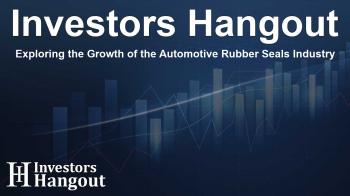Exploring the Growth of the Automotive Rubber Seals Industry

Understanding the Automotive Rubber Seals Market Growth
The automotive rubber seals market is on the brink of significant growth, projected to surge from USD 8.40 billion to USD 10.74 billion by 2032. This rise, at a CAGR of 3.6%, emphasizes the increasing importance placed on vehicle safety and performance efficiencies. The surge is driven by regulatory demands for enhanced noise and vibration control and the need for innovations in sealing technology.
Key Drivers of Market Expansion
Several factors contribute to the growth of the automotive rubber seals sector. Key among these are regulatory requirements concerning vehicle safety standards like ECE R43 and FMVSS 205, which lead OEMs to implement cutting-edge sealing technologies. These technologies are not only crucial for improving noise and vibration reduction but also for providing better thermal insulation and protection against environmental elements such as dust and water ingress.
Advancements in Sealing Technologies
The burgeoning complexity of modern vehicles, particularly with the introduction of Advanced Driver-Assistance Systems (ADAS) and lightweight designs, amplifies the demand for multifunctional sealing solutions. These solutions include precision-engineered glass run channels, encapsulations, and door seals. Firms like Cooper Standard are making strides with modular sealing systems tailored for high-volume vehicles, while Toyoda Gosei is focused on innovations designed for premium automobiles.
Challenges Facing Manufacturers
Despite the market's growth, manufacturers are grappling with significant challenges. Fluctuations in the prices of synthetic rubber materials, like EPDM and NBR, due to their linkage with crude oil prices, create unpredictability in manufacturing costs. Additionally, there is an increasing demand for sustainable solutions in tire and seal manufacturing that comply with recycling standards while maintaining performance under rigorous conditions.
Electric Vehicles Leading the Way
Electric vehicles (EVs) are currently a key focus in the automotive rubber seals market. The glass run channels essential for EVs demand high precision, especially as not all manufacturing meets the exact tolerances required for optimal performance under various environmental conditions. This requirement is compelling manufacturers to create seals that can withstand temperatures from -40°C to +120°C while also performing reliably across a wide range of conditions.
Growth of Heavy Commercial Vehicles
Heavy commercial vehicles (HCVs) are expected to drive the fastest growth in the automotive sealing market. The increase in freight volumes and the stringent safety regulations necessitate robust sealing solutions that can absorb vibration and intensive wear from heavy-duty applications. As the industry moves towards electrification, these rubber seals will also need to meet higher standards of performance and sustainability.
Regional Insights on Market Potential
Regionally, Europe is anticipated to be the fastest-growing market for automotive rubber seals as it adapts to stricter regulations, evolving consumer expectations for lightweight vehicles, and advancements in sealing technology. Countries such as Germany lead the charge, supported by their strong automotive manufacturing base and ongoing investment in research and development.
Key Market Players
Major players in the automotive rubber seals industry include renowned companies like Cooper Standard, Toyoda Gosei, and Hutchinson. These firms are pivotal in shaping the future of automotive sealing technologies through innovative products and strategic investments that adhere to the evolving needs of OEMs.
Frequently Asked Questions
What is the future outlook for the automotive rubber seals market?
The automotive rubber seals market is expected to grow significantly, reaching approximately USD 10.74 billion by 2032, driven by technological advancements and increasing vehicle safety regulations.
What factors are pushing manufacturers towards innovation?
Regulatory pressures for improved vehicle safety and acoustics, along with the demand for enhanced durability and sustainability in materials, are key drivers of innovation in seal manufacturing.
Are electric vehicles influencing the automotive rubber seals market?
Yes, electric vehicles are a major growth segment, requiring high-precision sealing solutions that enhance performance and comply with stringent industry standards.
What challenges is the market facing?
Manufacturers face challenges such as fluctuating raw material costs and the need to develop sustainable solutions that also meet high-performance standards.
Which regions are leading the growth in this market?
Europe, particularly Germany, is leading the growth due to strong automotive manufacturing, regulatory developments, and an emphasis on lightweight and efficient vehicle designs.
About The Author
Contact Dominic Sanders privately here. Or send an email with ATTN: Dominic Sanders as the subject to contact@investorshangout.com.
About Investors Hangout
Investors Hangout is a leading online stock forum for financial discussion and learning, offering a wide range of free tools and resources. It draws in traders of all levels, who exchange market knowledge, investigate trading tactics, and keep an eye on industry developments in real time. Featuring financial articles, stock message boards, quotes, charts, company profiles, and live news updates. Through cooperative learning and a wealth of informational resources, it helps users from novices creating their first portfolios to experts honing their techniques. Join Investors Hangout today: https://investorshangout.com/
The content of this article is based on factual, publicly available information and does not represent legal, financial, or investment advice. Investors Hangout does not offer financial advice, and the author is not a licensed financial advisor. Consult a qualified advisor before making any financial or investment decisions based on this article. This article should not be considered advice to purchase, sell, or hold any securities or other investments. If any of the material provided here is inaccurate, please contact us for corrections.

